 W
WAnas is a genus of dabbling ducks. It includes the pintails, most teals, and the mallard and its close relatives. It formerly included additional species but following the publication of a molecular phylogenetic study in 2009 the genus was split into four separate genera. The genus now contains 31 living species. The name Anas is the Latin for "duck".
 W
WThe African black duck is a species of duck of the genus Anas. It is genetically closest to the mallard group, but shows some peculiarities in its behavior and plumage; it is accordingly placed in the subgenus Melananas pending further research.
 W
WThe American black duck is a large dabbling duck in the family Anatidae. It was described by William Brewster in 1902. It is the heaviest species in the genus Anas, weighing 720–1,640 g (1.59–3.62 lb) on average and measuring 54–59 cm (21–23 in) in length with a 88–95 cm (35–37 in) wingspan. It somewhat resembles the female mallard in coloration, but has a darker plumage. The male and female are generally similar in appearance, but the male's bill is yellow while the female's is dull green with dark marks on the upper mandible. It is native to eastern North America. During the breeding season, it is usually found in coastal and freshwater wetlands from Saskatchewan to the Atlantic in Canada and the Great Lakes and the Adirondacks in the United States. It is a partially migratory species, mostly wintering in the east-central United States, especially in coastal areas.
 W
WThe wigeons or widgeons are a group of birds, dabbling ducks currently classified in the genus Mareca along with two other species. There are three extant species of wigeon, in addition to one recently extinct species.
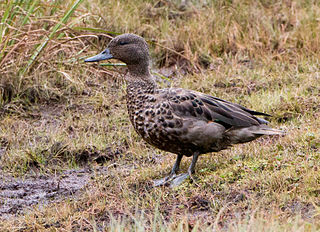 W
WThe Andean teal is a South American species of duck. Like other teals, it belongs to the diverse genus Anas; more precisely it is one of the "true" teals of subgenus Nettion. It is restricted to the Andean highlands of Colombia, Venezuela, and Ecuador. It inhabits freshwater wetlands, preferring palustrine habitat to rivers. It is not considered threatened by the IUCN.
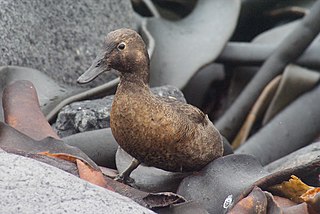 W
WThe Auckland teal or Auckland Islands teal is a species of dabbling duck of the genus Anas that is endemic to Auckland Islands south of New Zealand. The species was once found throughout the Auckland Islands but is now restricted to the islands that lack introduced predators: Adams Island, Enderby Island, Disappointment Island and a few smaller islands. An old report of "the same flightless duck" on North East Island, The Snares group most likely refers to a straggler.
 W
WBernier's teal, also known as the Madagascar teal, is a species of duck in the genus Anas. It is endemic to Madagascar, where it is found only along the west coast. Part of the "grey teal" complex found throughout Australasia, it is most closely related to the Andaman teal.
 W
WThe brown teal is a species of dabbling duck of the genus Anas native to New Zealand. For many years it had been considered to be conspecific with the flightless Auckland and Campbell teals in Anas aucklandica; the name "brown teal" has also been largely applied to that entire taxon. Common in the early years of European colonisation, the "brown duck" was heavily harvested as a food source. Its numbers quickly fell, especially in the South Island, and in 1921 they became fully protected. Captive breeding and releasing into predator-controlled areas has seen good localised populations re-introduced around the country in recent years.
 W
WThe Campbell teal or Campbell Island teal is a small, flightless, nocturnal species of dabbling duck of the genus Anas endemic to the Campbell Island group of New Zealand. It is sometimes considered conspecific with the brown teal. The plumage is similar to that of the Auckland teal, dark sepia with the head and back tinged with green iridescence, and a chestnut breast on the male, with the female dark brown all over. Its natural habitat is tussock grassland dominated by Poa tussock grass, ferns and megaherbs. The species also uses the burrows and pathways of petrel species that nest on the islands. They are apparently territorial in the wild, and probably feed on amphipods and insects.
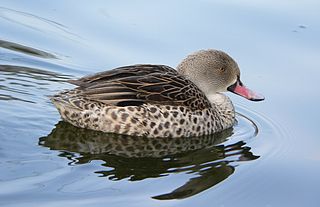 W
WThe Cape teal is a 44–46 cm long dabbling duck of open wetlands in sub-Saharan Africa.
 W
WThe South Georgia pintail, also misleadingly known as the South Georgian teal, is the nominate subspecies of the yellow-billed pintail, a duck in the dabbling duck subfamily Anatinae. It is endemic to the large (3,756 km2) subantarctic island of South Georgia and its accompanying archipelago, and is a vagrant to the South Sandwich Islands. It was among the birds noted by James Cook in January 1775, on the occasion of the first recorded landing on South Georgia, and was formerly considered a full species.
 W
WThe chestnut teal is a dabbling duck found in Australia. It is protected under the National Parks and Wildlife Act 1974.
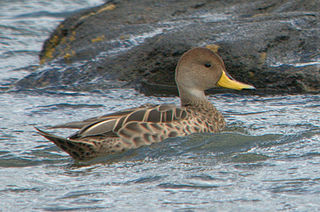 W
WThe Chilean pintail, also known as the golden peck duck or brown pintail, is a subspecies of the yellow-billed pintail, a duck in the dabbling duck subfamily Anatinae. Its local names are pato jergón grande, pato maicero and pato piquidorado in Spanish, and marreca-parda or marreca-danada in Portuguese.
 W
WThe eastern spot-billed duck or Chinese spot-billed duck is a species of dabbling duck that breeds in East and Southeast Asia. This species was formerly considered a subspecies of the Indian spot-billed duck and both were referred to as the spot-billed duck. The name is derived from the yellow spot on the bill.
 W
WEaton's pintail is a dabbling duck of the genus Anas. It is also known as the southern pintail. The species is restricted to the island groups of Kerguelen and Crozet in the southern Indian Ocean. It resembles a small female northern pintail. It was named after the English explorer and naturalist Alfred Edmund Eaton. It is threatened by introduced species, particularly feral cats, which prey on it.
 W
WThe green-winged teal is a common and widespread duck that breeds in the northern areas of North America except on the Aleutian Islands. It was considered conspecific with the Eurasian teal for some time but the issue is still being reviewed by the American Ornithological Society; based on this the IUCN and BirdLife International do not accept it as a separate species at present. However, nearly all other authorities consider it distinct based on behavioral, morphological, and molecular evidence. The scientific name is from Latin Anas, "duck" and carolinensis, "of Carolina".
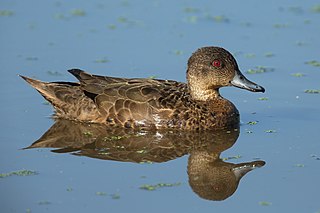 W
W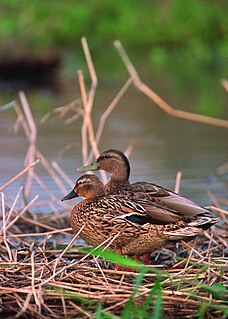 W
WThe Hawaiian duck or koloa is a species of bird in the family Anatidae that is endemic to the large islands of Hawaiʻi. Taxonomically, the koloa is closely allied with the mallard. It differs in that it is monochromatic and non-migratory. As with many duck species in the genus Anas, Hawaiian duck and mallards can interbreed and produce viable offspring, and the koloa has previously been considered an island subspecies of the mallard. However, all major authorities now consider this form to be a distinct species within the mallard complex. Recent analyses indicate that this is a distinct species that arose through ancient hybridization between mallard and Laysan duck. The native Hawaiian name for this duck is koloa maoli, or simply koloa. This species is listed as endangered by the IUCN Red List of Threatened Species, and its population trend is decreasing.
 W
WThe Indian spot-billed duck is a large dabbling duck that is a non-migratory breeding duck throughout freshwater wetlands in the Indian subcontinent. The name is derived from the red spot at the base of the bill that is found in the mainland Indian population. When in water it can be recognized from a long distance by the white tertials that form a stripe on the side, and in flight it is distinguished by the green speculum with a broad white band at the base. This species and the eastern spot-billed duck were formerly considered conspecific, together called the spot-billed duck.
 W
WThe Laysan duck, also known as the Laysan teal, is a dabbling duck endemic to the Hawaiian Islands. Fossil evidence reveals that Laysan ducks once lived across the entire archipelago, but today survive only on Laysan Island and two atolls. The duck has several physical and behavioral traits linked to the absence of ground-based predators in its habitat. By 1860, the ducks had disappeared from everywhere except Laysan Island. The introduction of rabbits brought the bird to the brink of extinction in 1912 with twelve surviving individuals. Rabbits were eradicated from the island in 1923 and numbers of Laysan ducks began to rise, reaching 500 by the 1950s. In an effort to ensure the long-term future of this duck, 42 birds were translocated to Midway Atoll National Wildlife Refuge in 2002. These thrived in their new surroundings, and another group were later relocated to Kure Atoll.
 W
WThe mallard is a dabbling duck that breeds throughout the temperate and subtropical Americas, Eurosiberia, and North Africa and has been introduced to New Zealand, Australia, Peru, Brazil, Uruguay, Argentina, Chile, Colombia, the Falkland Islands, and South Africa. This duck belongs to the subfamily Anatinae of the waterfowl family Anatidae. The male birds (drakes) have a glossy green head and are grey on their wings and belly, while the females have mainly brown-speckled plumage. Both sexes have an area of white-bordered black or iridescent blue feathers called a speculum on their wings; males especially tend to have blue speculum feathers. The mallard is 50–65 cm (20–26 in) long, of which the body makes up around two-thirds the length. The wingspan is 81–98 cm (32–39 in) and the bill is 4.4 to 6.1 cm long. It is often slightly heavier than most other dabbling ducks, weighing 0.72–1.58 kg (1.6–3.5 lb). Mallards live in wetlands, eat water plants and small animals, and are social animals preferring to congregate in groups or flocks of varying sizes. This species is the main ancestor of most breeds of domesticated ducks.
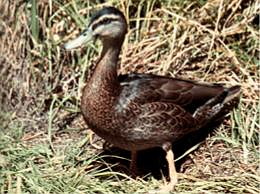 W
WThe Mariana mallard or Oustalet's duck is an extinct type of duck of the genus Anas that was endemic to the Mariana Islands. Its taxonomic status is debated, and it has variously been treated as a full species, a subspecies of the mallard or of the Pacific black duck, or sometimes as a subspecies of the Indian spot-billed duck.
 W
WThe Mascarene teal, also known as Sauzier's teal and Mauritian duck, is an extinct dabbling duck that formerly occurred on the islands of Mauritius and Réunion. It was a small teal of the Anas gibberifrons superspecies of the Anas subgenus Nettion. Its closest relative is probably Bernier's teal from Madagascar and, apart from having stronger wings and being considerably bigger, it seems to have looked very similar to that species. Earlier, it was proposed that Meller's duck, also from Madagascar, is the closest living relative of A. theodori, but as more remains of the latter were unearthed this appears far less likely. Apart from a few, brief descriptions, not much is known about the bird in life, but its habits probably did not differ significantly from those of its close relatives. Bones have been found in the Mare aux Songes swamp on Mauritius and more recently on Réunion also. The scientific name honours Thé́odore Sauzier, who made many bones of extinct birds found on Mauritius available to science.
 W
WMeller's duck is a species of the dabbling duck genus Anas. It is endemic to eastern Madagascar. Although a population was established on Mauritius in the mid-18th century, this is on the verge of extinction due to habitat loss and competition by feral domestic ducks. The species name of this species is after the botanist Charles James Meller, and its generic name is from the Latin for "duck".
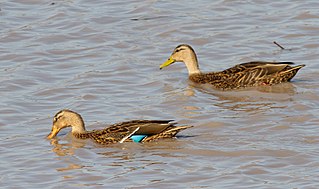 W
WThe Mexican duck is a species of dabbling duck that breeds in Mexico and the southwestern United States. Most of the population is resident, but some northern birds migrate south to Mexico in winter. The species also occurs widely, but in limited numbers, in Colorado in all seasons and there are photographs of birds referable to this taxon from Utah, Wyoming, Nebraska, and Montana.
 W
WThe mottled duck or mottled mallard is a medium-sized dabbling duck. It is intermediate in appearance between the female mallard and the American black duck. It is closely related to those species, and is sometimes considered a subspecies of the former, but this is inappropriate.
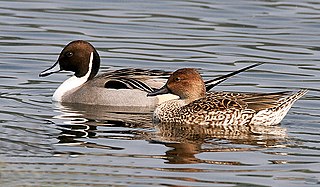 W
WThe pintail or northern pintail is a duck with wide geographic distribution that breeds in the northern areas of Europe and across the Palearctic and North America. It is migratory and winters south of its breeding range to the equator. Unusually for a bird with such a large range, it has no geographical subspecies if the possibly conspecific duck Eaton's pintail is considered to be a separate species.
 W
WThe Pacific black duck, commonly known as the PBD, is a dabbling duck found in much of Indonesia, New Guinea, Australia, New Zealand, and many islands in the southwestern Pacific, reaching to the Caroline Islands in the north and French Polynesia in the east. It is usually called the grey duck in New Zealand, where it is also known by its Maori name, pārera.
 W
WThe Philippine duck is a large dabbling duck of the genus Anas. Its native name is papan. It is endemic to the Philippines. As few as 5,000 may remain. Overhunting and habitat loss have contributed to its decline.
 W
WThe red-billed teal or red-billed duck is a dabbling duck which is an abundant resident breeder in southern and eastern Africa typically south of 10° S. This duck is not migratory, but will fly great distances to find suitable waters. It is highly gregarious outside the breeding season and forms large flocks.
 W
WThe Sunda teal, also known as the Bebek cokelat or Itik benjut, is a dabbling duck found in open wetlands in Indonesia. The species formerly included the Andaman teal Anas albogularis and the grey teal, Anas gracilis as subspecies, but is currently considered monotypic.
 W
WThe Eurasian teal, common teal, or Eurasian green-winged teal is a common and widespread duck which breeds in temperate Eurosiberia and migrates south in winter. The Eurasian teal is often called simply the teal due to being the only one of these small dabbling ducks in much of its range. The bird gives its name to the blue-green colour teal.
 W
WThe white-cheeked pintail, also known as the Bahama pintail or summer duck, is a species of dabbling duck. It was first described by Carl Linnaeus in his landmark 1758 10th edition of Systema Naturae under its current scientific name.
 W
WThe yellow-billed duck is a 51–58 cm long dabbling duck which is an abundant resident breeder in southern and eastern Africa.
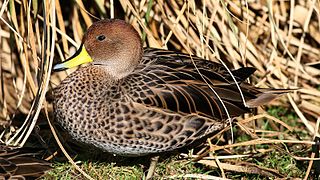 W
WThe yellow-billed pintail is a South American dabbling duck of the genus Anas with three described subspecies.
 W
WThe yellow-billed teal is a South American species of duck. Like other teals, it belongs to the diverse genus Anas; more precisely it is one of the "true" teals of subgenus Nettion. It occurs in Argentina, the Falkland Islands, Chile, Peru, Bolivia, Uruguay, and Brazil. It has also established itself in South Georgia, where it was first recorded breeding in 1971, and has been recorded as far east as Tristan da Cunha. It inhabits freshwater wetlands, preferring palustrine habitat to rivers. Considering its wide range and local abundance, it is not considered threatened by the IUCN.